INDUCTION Induction and Manual Handling Refresher Course V








































































































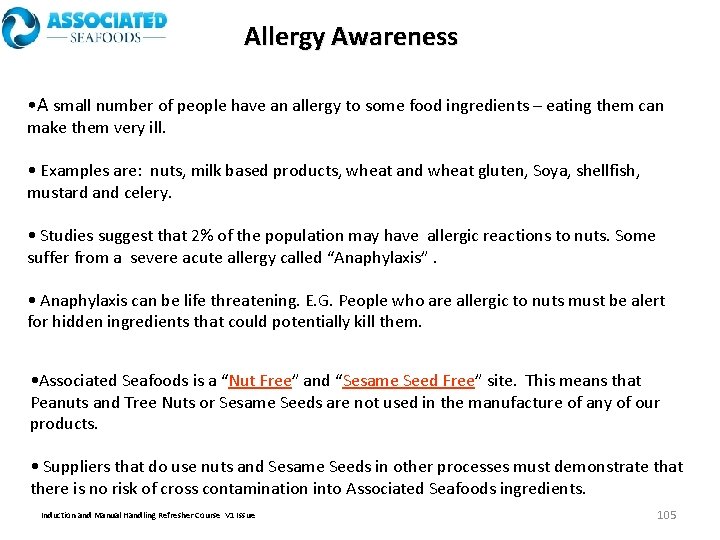
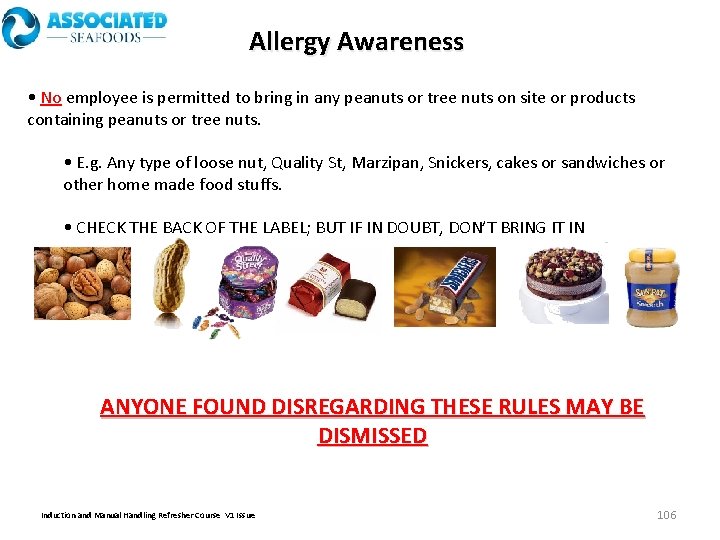

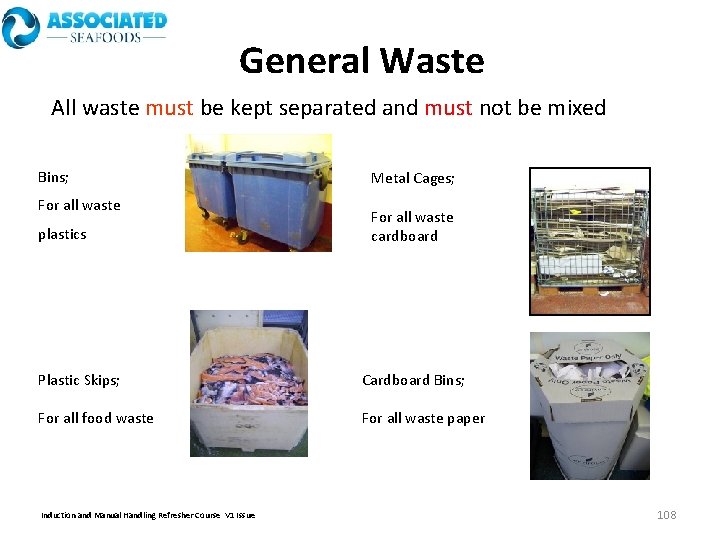
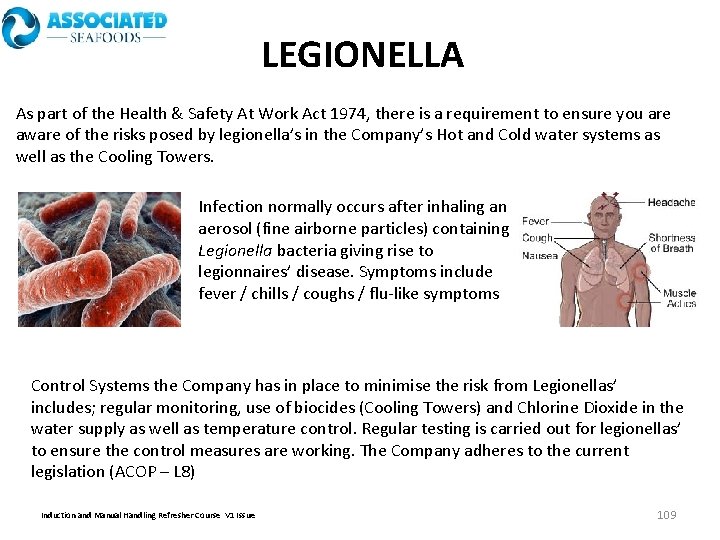
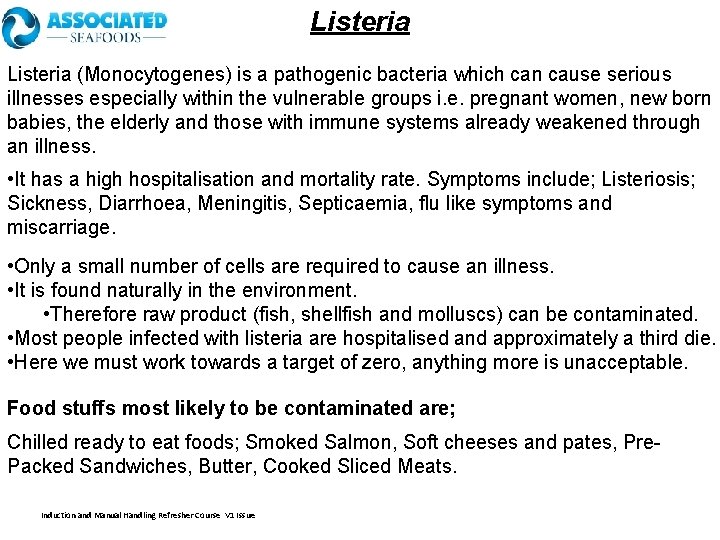
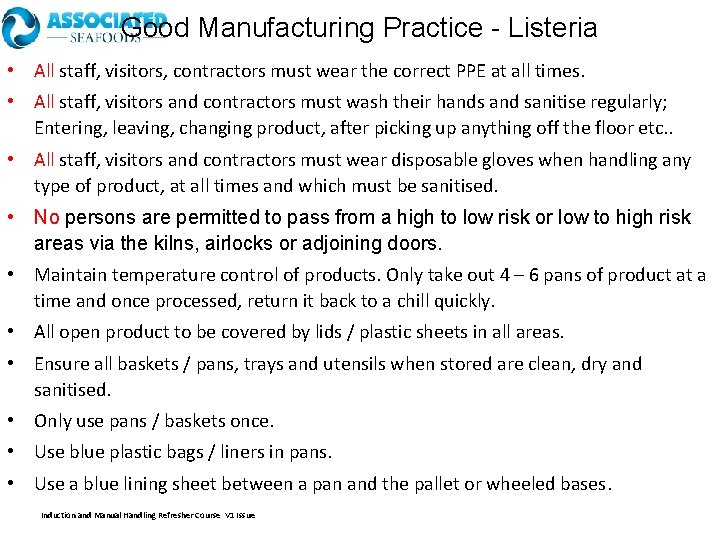
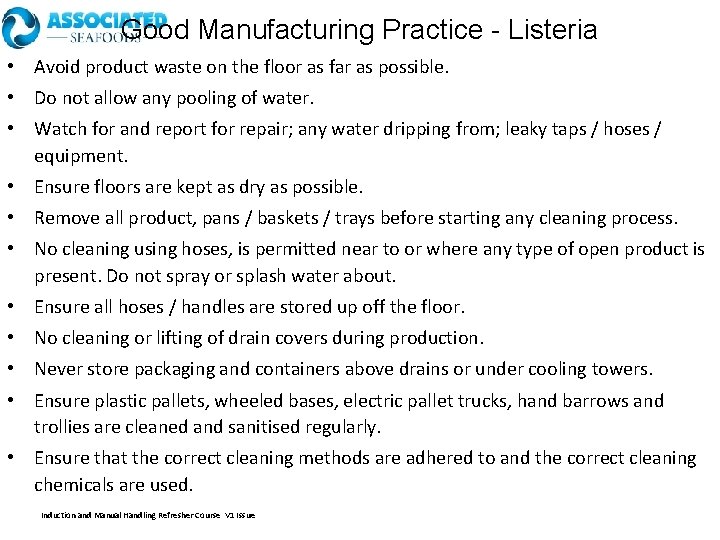
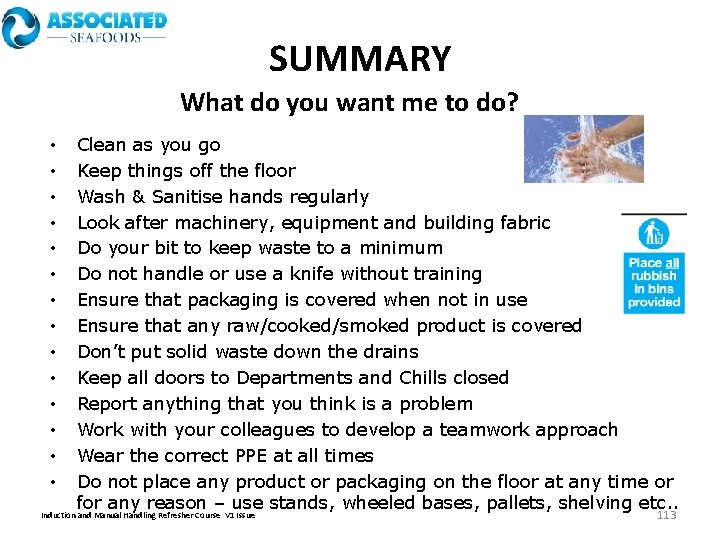
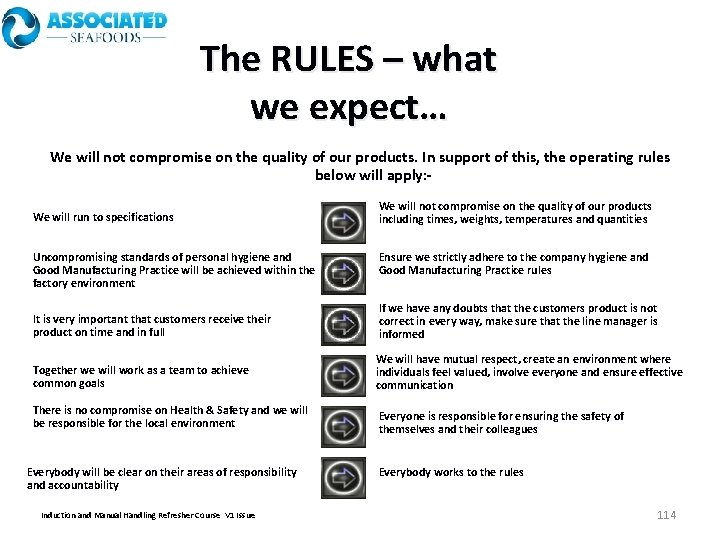
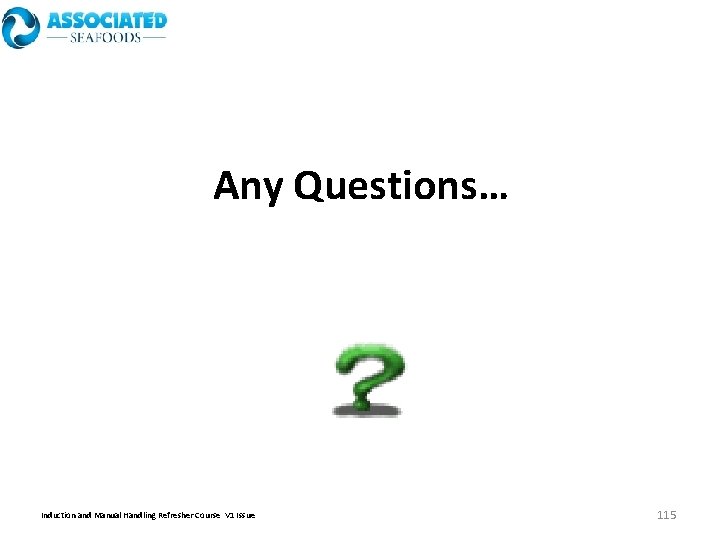
- Slides: 115

INDUCTION Induction and Manual Handling Refresher Course V 1 Issue

Ethical Trading We, as a Company, are now a part of the Ethical Trading Initiative, this means that we follow the E. T. I Base Code, in that: • Employment is freely chosen • Freedom of Association and the right to collective bargaining are respected • Working conditions are safe and hygienic • Child labour shall not be used • Living wages are paid • Working hours are not excessive • No discrimination is practiced • Regular employment is provided • No harsh or inhumane treatment is allowed Induction and Manual Handling Refresher Course V 1 Issue 2

Stronger Together • Be Personnel is working within Stronger Together (ST) principles to help eradicate Modern Slavery • Resources available to you at www. stronger 2 gether. org • further information is contained in your Welcome leaflet • We will now go through an ST Presentation Induction and Manual Handling Refresher Course V 1 Issue

Teamworking SO WHAT MAKES A GOOD TEAM? • • • Everyone working towards the same goals Different roles / skills Everyone involved Good communication People valued / mutual respect Good Leadership Induction and Manual Handling Refresher Course V 1 Issue 4

Team Roles Manufactu ring Controller Technical t Departmen Managers QC Production Supervisors tors c e p Ins ering Engine r Manage Induction and Manual Handling Refresher Course V 1 Issue Operatives Chargehan ds ager n a M ne Hygie artment Production Dep Managers Eng inee rs H&SM anager 5

Equality & Diversity Associated Seafoods Ltd: • Are committed to the elimination of unfair discrimination because of a characteristic protected under the Equality Act 2010. The 9 protected characteristics are; age, disability, race, gender reassignment, marriage & civil partnership, pregnancy & maternity, religion & belief (including lack of belief), sexual orientation. • Will strive to ensure all decisions on individuals employment and development and that of potential colleagues are objective, based on merit and support business goals. • Recognises that the contribution of a diverse workforce which reflects local community in cultural and different life experiences will enhance potential for creativity, vitality, greater innovation and positively motivate employees. Induction and Manual Handling Refresher Course V 1 Issue 6

Dignity at Work Associated Seafoods Ltd: • Are committed to having a workplace free from bullying and harassment and recognise the serious consequences of this to employees and to the company. This won’t be tolerated or condoned within work or outside work if it has an impact on working relationships. • Will not accept any form of bullying, harassment, victimisation, intimidation or behaviour which causes employees distress. • Defines workplace bullying and harassment as ‘unwanted and unwelcomed behaviour which makes the recipient feel unpleasant or uncomfortable. • Disciplinary action will be taken against employees committing any form of bullying or harassment. Induction and Manual Handling Refresher Course V 1 Issue 7

Dealing with Bullying and Harassment Full procedure is contained within the Employee Handbook. It is preferable that complaints are dealt with informally where appropriate. • Make the person aware of the impact of their behaviour. • Ask them to stop. • If you are uncomfortable doing so, ask a colleague or more senior manager to do it for you Where the informal approach is inappropriate/fails, or if the harassment is more serious you should bring the matter to the attention of your manager or the HR Manager as a formal written complaint. Individuals who wish to express their concern/complaint anonymously can do so by using the suggestion box located in the changing area. False or malicious accusations will be dealt with under the disciplinary procedure. Induction and Manual Handling Refresher Course V 1 Issue 8

Promoting Tolerance • It is easy to take a one sided view and assume that how we see things is the way that everyone sees them. • BUT all people are different individuals, with their own culture. We can’t change this, but we can change the way we react to it. We can think before we speak and consider the other person’s feelings. We can let ourselves see things from someone else’s point of view. We can help to promote tolerance and team spirit. Induction and Manual Handling Refresher Course V 1 Issue 9

Site Security • All members of staff are asked to ensure that any unidentified or unknown visitors (including exemployees) that come onto the site are challenged and/or reported to supervisors/managers. • No person is permitted to enter the factory even to use the toilet or use the canteen (e. g. a lorry driver) unless they have reported to reception first. • This is necessary to ensure the security of the site for both individuals and the wider business. • Remember - if you are unsure then please report it! Induction and Manual Handling Refresher Course V 1 Issue 10

Breaks Employees are permitted two breaks during the day – One of paid 20 mins and one of unpaid 20 mins (line to line) • You are not permitted to use the smoke shelter facility outside your official breaks • If you are late back to your department without due cause, you could face disciplinary action Leaving your department during working hours There are sometimes reasons why you need to leave your department e. g. To go to the toilet, to get something from another department. You must inform your Supervisor or Chargehand. This is so that we know where you are in the event of a fire etc Induction and Manual Handling Refresher Course V 1 Issue 11

Rules on Smoking Materials are not permitted to be taken onto the production floor. Remove your coat, factory shoes/boots and mob cap before going for a smoke. You MUST wash your hands thoroughly before resuming work. THE RULE IS: No Smoking ANYWHERE on Site (or in any of our vehicles) except in the Designated Smoking Area and during official breaks. Keep the smoking area clean and tidy at all times. Induction and Manual Handling Refresher Course V 1 Issue 12

Rules on Smoking (continued) E-CIGARETTES Whilst it is recognised that employees may use ecigarettes as an aid to give up smoking tobacco, it is not known if there any health risks to individuals from the vapours released by e-cigarettes. THE RULE IS: The use of e-cigarettes is not permitted in company buildings, company vehicles, in customer meetings, or whilst working on customer premises. There are no exceptions to this rule. Induction and Manual Handling Refresher Course V 1 Issue 13

No eating or drinking of any type of food or drink is permitted in or on the factory premises except in the canteen. No food (including sweets/gum) or drink is permitted to be taken onto the factory floor. All food must be stored correctly in the cupboard/fridges in the canteen Kept the canteen clean and tidy at all times by clearing up after yourself Induction and Manual Handling Refresher Course V 1 Issue 14

Mobile Phones Etc • All mobile phones / I Pods etc must be left in your locker. • No mobile phones / I Pods etc are permitted to taken onto the factory floor. • Only authorised Company mobile phones are allowed. Induction and Manual Handling Refresher Course V 1 Issue 15

Changes In Personal Circumstances You must inform Human Resources of any changes to your Personal Circumstances to enable your file to be kept up to date, e. g. if you change your: Ø Name Ø Next of kin Ø Address Ø Telephone number Personal Details forms are available in the Canteen. Induction and Manual Handling Refresher Course V 1 Issue 16

Absence From Work • If you are unable to attend work due to sickness or ill health, you must notify us by telephone on the 1 st day of incapacity by telephoning 07580 959634 and leaving a message. Other than in exceptional circumstances notification should be made personally. It is not acceptable to send a text message. • You should notify us within 2 hrs of your usual start time (or within 2 hrs of your shift start time if you are a shift worker). • If you are comfortable doing so explain what is wrong with you. • You must inform us if your sickness could have an effect on other people, such as Mumps or German Measles (Rubella), Pandemic Flu etc. • You must inform us if your absence is due to an injury at work. • After any absence all employees are required to compete a return to work form and may be required to attend an individual return to work interview. Induction and Manual Handling Refresher Course V 1 Issue 17

Grievance Procedure Any employee who feels aggrieved about the way they have been treated has the right to express their views and have issues resolved in a fair manner. A grievance may be raised about any matter concerning work or conditions of employment other than. The grievance procedure seeks to achieve solutions through informal methods prior to the use of formal processes; • it is concerned with achieving a mutually acceptable resolution rather than establishing guilt or innocence; • it does not provide for sanctions against anyone involved. Individuals who do not wish to use the informal or formal grievance procedure, or wish to express their concern/complaint anonymously, can do so by using the suggestion box located in the changing area. Where separate procedures exist to deal with specific types of grievance (e. g. harassment or whistle blowing) employees should use them instead. Induction and Manual Handling Refresher Course V 1 Issue 18

Disciplinary & Capability The purpose of the Disciplinary Procedure is to: • Promote fairness and order in the treatment of individuals. • Encourage improvement to meet required standards. • Not merely a means of punishment. 4 Stage procedure 1) Formal Verbal Warning 2) Written Warning 3) Final Written Warning 4) Dismissal Induction and Manual Handling Refresher Course V 1 Issue 19

Examples of Misconduct These are examples only and not an exhaustive list. Unsatisfactory Conduct and Misconduct: • Failure to report immediately any damage to property or premises caused by you • Persistent lateness or unauthorised absence from work • Unsatisfactory standards or output of work • Unauthorised use of Email or internet • Failure or refusal to carry out reasonable instruction • Rudeness towards other employees, customers or members of the public • Using insulting or objectionable behaviour or bad language • Insubordination • If your work involves driving, failure to report immediately any type of driving conviction Induction and Manual Handling Refresher Course V 1 Issue 20

Examples of Misconduct Gross Misconduct: • • Physical violence or bullying Deliberate damage to property The use, handling or possession of illegal drugs on Company premises Being found unfit/unsafe to carry out duties because of alcohol/drugs Serious negligence which causes unacceptable loss, damage or injury Failure to comply with Health & Safety Legislation Actions which bring your integrity into question or activities out with work that result in adverse publicity for the Company • Unauthorised use of any lifting equipment; Forklift, Scissor Lift, Reach Truck or Electric Barrows • Spitting anywhere on site, LAW • Eating or drinking in unauthorised areas Induction and Manual Handling Refresher Course V 1 Issue 21

Misconduct Cont…. . Serious Misconduct: Where an unsatisfactory conduct or misconduct rule has been broken and it is shown to be due to extreme carelessness or has a serious effect on our operation or reputation a final written warning may be issued as a first course of action. A final written warning may be issued as the first course action, if, in an alleged gross misconduct matter there is shown to be some level of mitigation resulting in it being treated as an offence jut short of dismissal. Employees have the right to lodge an appeal in respect to any capability/disciplinary action taken against them. Induction and Manual Handling Refresher Course V 1 Issue 22

Capability Procedure The purpose of our Disciplinary Procedure is to ensure fair and consistent treatment of all employees who fail to meet the accepted standard e. g. ; • Conduct • Job Performance • Attendance / Lateness 4 Stage procedure 1) Verbal Warning 2) Written Warning 3) Final Written Warning 4) Dismissal (Gross Misconduct) Induction and Manual Handling Refresher Course V 1 Issue 23

PERSONAL HYGIENE Induction and Manual Handling Refresher Course V 1 Issue

Personal Protective Equipment • PPE is given out as a means of protection to the food. • PPE must be worn correctly and worn in the right order; Mobcap, shoes/boots, coat. • It is the employee’s responsibility to inspect any PPE issued to them on a regular basis and to renew any PPE if it is worn and/or damaged immediately. • PPE is not to be worn outside by food handlers or when going for a smoke. • PPE is not to be worn when going for any break or in the toilets. • No disposable PPE is permitted to be left on coats etc as this can cause cross-contamination. • No spare disposable PPE can be carried in pockets etc at any time as this will cause cross-contamination. Induction and Manual Handling Refresher Course V 1 Issue

MOB CAPS…. . ALL AREAS …. Men • Must be put on BEFORE your Coat • Must cover your ears • Must cover all of your Hair • May not be tied • Must be removed and replaced after smoking Induction and Manual Handling Refresher Course V 1 Issue Snoods must be worn if unshaved for two days or more, or if you have a beard and/or a moustache 26

MOB CAPS…. . ALL AREAS… Women • Hair must only be secured with a plain elasticated band • Must be on BEFORE your Coat • Must cover your ears • Must cover all of your Hair • May not be tied • Must be removed and replaced after smoking Induction and Manual Handling Refresher Course V 1 Issue 27

PPE SUMMARY Always wear the correct issued PPE for the area you work in or for the job you are doing. SAFETY STARTS WITH YOU!!! Induction and Manual Handling Refresher Course V 1 Issue 28

Entry to a Department • The rules must be followed when entering a Low or High Care area. • Only enter that area if you are authorised to do so. • Ensure the changing / hand-washing procedure is followed at each step when entering a High Care area. • If you are unsure how to enter an area you have not been in before, ask! Induction and Manual Handling Refresher Course V 1 Issue

RESPONSIBILITY It is the responsibility of every person involved in food production including Food handlers to ensure they follow all the hygiene rules This is to ensure product safety You have not only a moral duty but also a legal duty If you knowingly break the rules then YOU can be prosecuted Induction and Manual Handling Refresher Course V 1 Issue

PERSONAL HYGIENE Food Handlers have a moral and legal responsibility to maintain high standards of personal hygiene: Hands !! Dirty Hands Can Lead to Prosecution!! Major Vehicle i. e. can pass on bacteria. Prime source of contamination. Fingernails MUST be kept short and clean. Induction and Manual Handling Refresher Course V 1 Issue

When must you wash your hands? Induction and Manual Handling Refresher Course V 1 Issue

OCCASIONS WHEN YOU MUST WASH YOUR HANDS By LAW you must wash hands after visiting the toilet You can be prosecuted if you do not comply. Must have a ‘Now Wash Your Hands’ sign. Toilet paper is porous, bacteria from the intestines are carried in the faeces. Induction and Manual Handling Refresher Course V 1 Issue

OCCASIONS WHEN YOU MUST WASH YOUR HANDS On entering OR leaving a department E. g. When starting or finishing your shift. Before and after a break. After Eating, Smoking, Blowing nose, touching the face Remember - Staphylococcus Aureus is present in nose, mouth, hair etc After handling waste of any type • Waste may be contaminated i. e. Product that has been on the floor. • Raising the lid of a dustbin can contaminate hands and clothing. • Picking up something from the floor, E. g. a knife. • If any product comes into contact with the floor, it must be disposed of to a waste pan. There is no 3, 5, 10 second rule, this is an old wives tale – once any product touches the floor, IT IS CONTAMINATED and cannot be used under any circumstances. Induction and Manual Handling Refresher Course V 1 Issue

OCCASIONS WHEN YOU MUST WASH YOUR HANDS After handling raw food • Raw food, meat and poultry may be contaminated by Salmonella • Raw vegetables may be contaminated by soil and Clostridium Perfringens. A good general rule is to wash your hands each and every time you pass a hand washing sink. Remember to sanitise your hands after washing them. Induction and Manual Handling Refresher Course V 1 Issue

AREAS COMMONLY MISSED DURING HAND WASHING Back Most Frequently Missed Less frequently Missed Induction and Manual Handling Refresher Course V 1 Issue Not Missed Front

How are you required to wash your hands? Induction and Manual Handling Refresher Course V 1 Issue

Hand Washing Technique • Wet hands • Apply a generous amount of antibacterial soap Induction and Manual Handling Refresher Course V 1 Issue

Hand Washing Technique 1. Rub hands palm to palm 2. Right hand over left back and left palm over right back. 3. Palm to palm and fingers interlaced. Induction and Manual Handling Refresher Course V 1 Issue

Hand Washing Technique 4. Backs of fingers to opposing palms with fingers interlocked 5. Rotational rubbing of the right thumb clasped in the left palm and visa versa 6. Rotational rubbing backward and forwards with clasped fingers of the right hand in the left palm and visa versa Induction and Manual Handling Refresher Course V 1 Issue

Hand Washing Technique 7. Rinse hands thoroughly and dry using the automatic hand driers or paper towels 8. Apply alcohol gel to the hands and repeat stages 2 – 7 and then allow to air dry Induction and Manual Handling Refresher Course V 1 Issue

PERSONAL HYGIENE You must wash/bathe regularly including your hair. • It is a breach of the law not to. • The smell is caused by bacteria which can be transmitted to the food. • Use non-perfumed soaps and non-perfumed deodorants, so that the smell does not taint the food. • By not washing or bathing regularly, it is offensive to your Co-Workers. • Your own clothing as well, must be clean and washed regularly. By washing regularly; • Helps to prevent contamination / cross contamination • Promotes a better working environment. • You stay within the law. Induction and Manual Handling Refresher Course V 1 Issue

PERSONAL HYGIENE • Fingernails – Must be kept short and clean. – NO: False nails, Nail Polish or Nail Varnish. • Make-Up – NO make-up of any kind can be worn. • This includes, but not limited to; Foundations, blushers, bronzers. • False eye lashes, eye liners, eye shadow or mascara. • Lipstick or lip gloss. Induction and Manual Handling Refresher Course V 1 Issue

PERSONAL HYGIENE • Hair • All of your head and ears must be covered by a hair net • If you have long hair you must use the additional blue string type hair net. • You are only allowed to use a plain elasticated hair band – No hair grips, plastic or metal types – No scrunches • Clothing • No sequins, glitter or additional buttons/studs THERE ARE NO EXCEPTIONS TO THIS RULES. Induction and Manual Handling Refresher Course V 1 Issue

What items of jewellery are you allowed to take onto the factory floor? Induction and Manual Handling Refresher Course V 1 Issue

NO JEWELLERY OF ANY KIND Jewellery includes: watches, necklaces, bracelets, earrings, facial piercing and tongue studs. No hair jewellery may be worn such as hair beads etc. No charity bands are allowed to be worn. Only Jewellery permitted to wear: ONE Plain stone-less wedding ring Why? Jewellery carries Bacteria which can contaminate food. Clothing/hair bands must not have any sequins on them. Induction and Manual Handling Refresher Course V 1 Issue

CUTS AND WOUNDS Cuts, Spots, Pimples can all harbour Staphylococcus Aureus Must be covered with Company issue, blue, waterproof, metal detectable plasters. • Blue - for easy spotting if they fall into food. • Waterproof to prevent blood seepages and therefore protect the food - If they fall into food; food must be disposed of. • Metal strip in plasters – Helps with detection Induction and Manual Handling Refresher Course V 1 Issue

What medication are you allowed to take onto the factory floor? Induction and Manual Handling Refresher Course V 1 Issue

MEDICATION Tablets (of any kind) and liquid medication are not permitted in any food production areas. All medicines must remain with employees’ personal belongings in the lockers provided. If you have a medical condition; I. e. Diabetes or Asthma, which requires you to carry medication on your person, this must be agreed with the Company and the items must be clearly marked with your name. Induction and Manual Handling Refresher Course V 1 Issue

IT IS AGAINST THE LAW TO SMOKE OUTWITH DESIGNATED SMOKING AREAS Transfers bacteria from the mouth to the fingers Causes coughing Contaminates /taints the product Contaminates work surfaces Produces an unpleasant environment You may only use the designated smoking area. SMOKING IS NOT PERMITTED ANY WHERE ELSE ON SITE Induction and Manual Handling Refresher Course V 1 Issue

What are the rules if you have sickness or diarrhoea? Induction and Manual Handling Refresher Course V 1 Issue

IF YOU ARE ILL - DO NOT HANDLE FOOD You are required by law to report first to your supervisor/manager if you have or are suffering from any of the following: – Diarrhoea – Sickness/vomiting – An upset stomach – Are suffering from, or carrying, a disease likely to be transmitted through food. – Contact with a foodborne disease Induction and Manual Handling Refresher Course V 1 Issue – Skin abrasions, infections, boils or spots. – A septic wound. – A cold. – A sore throat. – Contact with a suspected case of food poisoning.

IF YOU ARE ILL - DO NOT HANDLE FOOD • Before you can return to work, you must be 48 hours clear of all symptoms and medication. • If you see a doctor, you must tell them by law, that you work in a food business. • Prior to starting any work, You must fill out a Return to Work Form. • Working whilst infected with any of the above, is a breach of the law and can cause a food poisoning outbreak, for which you can be prosecuted. Induction and Manual Handling Refresher Course V 1 Issue

IF YOU BECOME ILL • If you become ill before or during your shift, you must; – NOT enter/re-enter your Department. – Tell you Supervisor immediately. • Get someone to inform your Supervisor. • Go to reception • In law, it states that; “. . . Anyone working in a food business, who is affected by any of these and is likely to come into contact with food through their work, must tell the business owner or manager immediately about the illness or symptoms and, if possible, what has caused them. ” Induction and Manual Handling Refresher Course V 1 Issue

SPITTING • Spitting is illegal anywhere on site. – You can be prosecuted for spitting • Spitting spreads bacteria • Spitting may lead to your dismissal Induction and Manual Handling Refresher Course V 1 Issue

Upper Limb Disorder (ULD) A ULD is a medical condition that can affect areas such as the fingers, wrist, forearm, elbow, upper arm, shoulder and can include the neck; Tenosynovitis, Carpal Tunnel Syndrome This can be caused by a variety of activities inside or outside of work, such as poor posture, repetitive actions, forceful actions, poor set up and use of computer keyboards etc. Some people are more susceptible to ULD’s than others. There are many different symptoms that may indicate an upper limb disorder. These could include weakness, stiffness, tingling, cramp, small lumps, pain, numbness and swelling in one or many parts of the upper limb. What to do if you think you have a ULD; Inform your line manager, who may look at the way you are carrying out the task and suggest something different, or you may be moved to another task to prevent the problem. You may be asked to speak with the Site Health & Safety Advisor who may make recommendations regarding the type of work you should / should not do going forward. You may be referred to the company Occupational Health specialist if the issue is not easily resolved. Your working arrangements may need to be altered in order to remove you from the risk. Induction and Manual Handling Refresher Course V 1 Issue 56

HEALTH AND SAFETY Induction and Manual Handling Refresher Course V 1 Issue

The Health & Safety at Work Act 1974 Section 2 “It shall be the duty of the employer to ensure, so far as is reasonably practicable. . ”; • The health, safety and welfare of its employees. • This extends to the provision of safe: - Ø Ø Ø Plant & Equipment Working Environment Access & Egress (Exit) • Provision of necessary: Ø Information Ø Instruction Ø Training & Supervision Induction and Manual Handling Refresher Course V 1 Issue 58

Employees’ Responsibility HEALTH & SAFETY AT WORK ACT- SECTION 7 Every Employee must: • Take reasonable care of his/ her own health & safety Ø You are your own H&S Officer Ø Good housekeeping • Take reasonable care for the Health & Safety of anyone who may be affected by your acts or omissions. Since January 2004 - the employee can go to court Induction and Manual Handling Refresher Course V 1 Issue 59

Clean as You Go • Keep your workstation/area clean and tidy and free from the build up of waste of any type. • Your untidiness may cause injury to yourself or others. • Remember, that you personally can be held to account in a Court of Law if you injure yourself or others and/or can lead to disciplinary action being taken against you. Induction and Manual Handling Refresher Course V 1 Issue

• All fire exits must be kept clear at all times. – Never block or partially block any fire exit. – If you see a fire exit being blocked by a person ask them not to. – If you see that a fire exit is blocked, remove and report it immediately to a supervisor and/or manager. – It is a criminal offence to block a fire exit under the Fire regulations (Scotland) Act and The Health and Safety Act 1976. – (It is also an offence to use a fire extinguisher as a door stop) Induction and Manual Handling Refresher Course V 1 Issue

Fire • If you discover a fire ? Ø You must immediately operate the nearest fire alarm call point Ø Inform a Supervisor/Manager Ø Switch off machinery if safe to do so Ø Follow the evacuation procedure Ø Do not re enter the building until given permission to do so • On hearing the alarm: ? Ø Go to your nearest safe exit Ø Following the green signs Ø Go to your Assembly Point Ø Wait for your roll call Ø Do not re-enter the building until given permission to do so Ø Report to any Fire Warden if unable to reach your own assembly point, walk round the exterior of the building to your assembly point Induction and Manual Handling Refresher Course V 1 Issue 62

Most Frequent Reasons for Accidents ! Slip, Trip or Fall ! Hand Injuries (Cuts) ! Striking Fixed Object ! Struck by Moving Object Induction and Manual Handling Refresher Course V 1 Issue 63

MANUAL HANDLING Legislation - Manual Handling Regulations 1992 (as amended) It is the Employer’s Duty to ensure their employees are not exposed to hazardous manual handling operations • You MUST lift within your own capacity and in accordance with your training • If you are not sure you are able to lift an object, you seek help or assistance or use a hand barrow Definition of Manual Handling; A Manual Handling operation may be defined as; “…any transporting or supporting of a load (including lifting, putting down, pushing or pulling, carrying or moving thereof) by hand or bodily force. ” Induction and Manual Handling Refresher Course V 1 Issue 64

Manual Handling Techniques 1. Assess your Ability 2. Assess the Load 3. Plan your Lift 4. Lifting Technique Induction and Manual Handling Refresher Course V 1 Issue 65

1. Assess your Ability Examples; • Are you Pregnant? • Have got a bad back or do you have back problems? • Are you ill? • Or are you recovering from an illness? • Are you physically able to lift the object? Induction and Manual Handling Refresher Course V 1 Issue 66

2. Assess the load to be lifted It’s Weight -Do you need help? -Can you make the load lighter or smaller • It’s Balance (Centre of Gravity) -Test it ? • Does it have Sharp Edges? • Does it have to be lifted? - Can You use a hand barrow instead? - Can you use a set of wheels? Induction and Manual Handling Refresher Course V 1 Issue 67

3. Plan Your Lift Where is it going? • Is the place it’s going clear? • Is the route clear? • Can you move in one go or do you need to rest? Induction and Manual Handling Refresher Course V 1 Issue 68

4. Lifting Technique • Place your feet at 10 to 2 • BEND your Knees • Back – Keep it straight and Upright • Neck and Head – Keep you chin up • Don’t jerk or twist as you lift • Load – Keep it close to your pelvis Induction and Manual Handling Refresher Course V 1 Issue 69

Manual Handling Summary • Instruction is given as a means of preventing avoidable : Ø FATIGUE Ø STRAIN Ø INJURY • Most strains and injuries are due to unnecessary stiffening of the body tissues and are therefore preventable • Everyone can benefit by employing manual handling techniques. Induction and Manual Handling Refresher Course V 1 Issue 70

Manual Handling Summary Points to remember; Practicing good lifting technique does not enable you to lift more than you could before – It means that, whatever your capabilities, your chances of INJURY are reduced. Use these good principles for lifting in different situations and don’t stick blindly to rules and procedures. Induction and Manual Handling Refresher Course V 1 Issue 71

Safety Do’s & Don'ts Take care at all times for the safety of yourself and others Look where you are going and proceed cautiously and carefully around the factory site. Don’t run or rush about. Better safe than sorry Don’t fool around or play practical jokes Clean up after yourself! Your untidiness or carelessness may cause injury to someone else Don’t leave things lying around on benches or in gangways Don’t obstruct fire exits Induction and Manual Handling Refresher Course V 1 Issue 72

Safety Do’s & Don'ts Don’t allow hair or clothing to hang loose Don’t attempt to operate any machine or equipment without proper instruction Make sure that you really understand what to do before you operate any piece of equipment on your own Don’t attempt to clean any machine, or any moving part, whilst it is in motion or clear any jammed product whilst in operation Don’t interfere with any machine safety equipment Don’t tamper with any electrical wiring or equipment Induction and Manual Handling Refresher Course V 1 Issue 73

Basic Lifting Equipment Easy to operate. Require little training! - However if you are unsure or have not used the equipment before, you should contact your Supervisor or Site Trainer before attempting to use any lifting equipment. Use them! This is what they are there for. Induction and Manual Handling Refresher Course V 1 Issue

Lifting Equipment Types of lifting equipment on site include; Forklifts Reach Trucks MWEP (Scissor Lifts) POEPT (Electric Barrows) Induction and Manual Handling Refresher Course V 1 Issue No person may operate any lifting equipment at any time or for any reason unless they have been trained and authorised by the Company. Do not ride on any lifting equipment, laden or unladen, at any time or for any reason. Do not interfere with any lifting equipment at any time or for any reason. It is a Gross Misconduct offence to ride on, interfere with, to operate or attempt to operate any lifting equipment on site without training and authorisation. This may result in disciplinary action being taken. 75

Notices/Signs These are coloured Blue/Red/Yellow/Green and must be followed E. g. ; Blue Signs; are mandatory and in some cases a legal requirement Induction and Manual Handling Refresher Course V 1 Issue 76

Notices/Signs Red Signs; Prohibition i. e. do not do. . . Hazard Warning Signs are Yellow Safe Condition are Green These signs are posted so that you do not injury yourself. OBEY them!! Induction and Manual Handling Refresher Course V 1 Issue 77

Accident Prevention Summary • Follow all SAFETY Notices and Instructions • Beware of all Hazards, Examples; …. . . • Report all Hazards Immediately to Supervisors or Charge Hands • Report all Accidents, injuries No matter how slight Immediately To First-Aider, Supervisor or Charge Hand • Report all near misses whether it involves injury or not • Ensure details are recorded on an Accident Form at the time of accident, by a First -Aider. • This is for your own protection Induction and Manual Handling Refresher Course V 1 Issue 78

C. O. S. H. H (Control of Substances Hazardous to Health) There are various types of chemicals used and stored on site; Acids, Alkalis, Caustic etc No employee may HANDLE or USE any chemicals or substances unless they have had the appropriate training. Any unauthorized handling or use of any chemicals may result in severe injury and/or result in a disciplinary hearing. Only trained and authorised persons can handle or use any chemical Induction and Manual Handling Refresher Course V 1 Issue 79

STANDARDS Induction and Manual Handling Refresher Course V 1 Issue

Why Are “Our Standards” Important? • Clear set of rules that everyone understands and uses • Everyone is working together with the same aims • To ensure that we have a safe, clean, pleasant environment to work in • We produce high quality, safe products • Delight the customer • Secure, growing business • = Job security Induction and Manual Handling Refresher Course V 1 Issue 81

Specification • WHAT IS A SPECIFICATION? • KEY POINTS ON OUR SPECIFICATION Ø Quantities Ø Weights Ø Temperatures Ø Time • WHY IS SPECIFICATION IMPORTANT? Ø Customer expectation Ø Product Quality Ø Protect the public Ø Cost • CHANGES TO SPECIFICATION Who’s involved & why Induction and Manual Handling Refresher Course V 1 Issue 82

Customer Procedures • • All customers have different depot times Customers reject if label not straight etc. We are fined for this. We are also fined for failure to supply Label in wrong place Induction and Manual Handling Refresher Course V 1 Issue Correct 83

Customer Procedures What is wrong with this? Label does not match product Induction and Manual Handling Refresher Course V 1 Issue 84

Raw Materials, Ingredients and Food • Must be stored correctly to prevent contamination – 0. 0 C to 5. 0 C • Must be labelled at all times • Must ensure that times and temperature requirements are met • Check use by dates (Stock rotation) Induction and Manual Handling Refresher Course V 1 Issue 85

Food Containers • Cardboard cases must be kept dry, clean and off the floor • Plastic pans that are used for product must not be allowed to touch the floor empty or filled. – They must be placed on stands, a set of wheels or stacked on a plastic pallet – Never place any pan, filled or empty onto the floor. – All pans used for product can only be used once. – Ensure the topmost pan is covered using lids/plastic sheets as applicable • Pay particular attention to this during cleaning and production activities • Any pan containing product or any packaging, if it has come into contact with the floor, must be disposed of. Induction and Manual Handling Refresher Course V 1 Issue 86

General Rules for Food Premises must be kept : Ø Clean Ø In good repair and condition • Specific requirements for rooms where food is prepared • Doors must be kept closed when not in use (to maintain temperature and avoid pests) • Surfaces in contact with food must be kept clean and in good condition. Induction and Manual Handling Refresher Course V 1 Issue 87

HOW TO PREVENT CONTAMINATION Report any pest/rodent sighting immediately Pests/Rodents Keep doors closed Keep all food & waste covered Chemicals - From cleaning Bacteria & Germs Induction and Manual Handling Refresher Course V 1 Issue Ensure surfaces/tools/utensils have been properly rinsed after having been cleaned with chemicals Follow the hygiene rules at all times especially washing hands, wear gloves or disposable gloves when handling product and remember to sanitise your gloves 88

HACCP • Within our HACCP food safety management system, we have a number of CCP’s e. g. Metal Detectors, sieving etc. • Everyone must understand that these CCP’s are critical to food safety and the consumer. • No person is permitted to carry out a CCP or part of a CCP including any paperwork associated with a CCP without training and authorisation. • Full training will be given to any individual who requires to undertake any CCP. • Remember - Only trained and company authorised people are permitted to interact with a CCP. Induction and Manual Handling Refresher Course V 1 Issue

Loma Systems M&S Tier A Metal Detection Training Metal Detection Checkweighing X-ray Inspection

Reason for inspecting products Food Safety We all have a moral and legal responsibility to protect the consumer Induction and Manual Handling Refresher Course V 1 Issue

What do we do to prevent Metal Contamination • Metal Detector on every production line. • All product must be inspected. No product is permitted to bypass a metal detector at any time or for any reason. • The Metal Detector is a Critical Control Point (CCP). Only those trained and authorised are permitted to interact with a metal detector. • Isolate potential contaminated packs and investigate thoroughly. • Test the Metal Detector at regular intervals by trained and authorised persons only Induction and Manual Handling Refresher Course V 1 Issue

General understanding of metal contaminants What are we trying to detect Many contaminants found in product will come from the equipment and machinery producing the product. Such as: Nuts, Bolts & Washers Bits of Cutting Blades Steel Shavings Wire etc. Other metal contaminants are sometimes already present in product. ( Poultry etc. ) Induction and Manual Handling Refresher Course V 1 Issue

Detection of Contaminants What a Metal Detector cannot detect Glass Stones, Ceramic and Cement Bones PVC & TFE • Packaging materials or belting material is not detectable – Natural Rubber – – Induction and Manual Handling Refresher Course V 1 Issue

General understanding of metal contaminants Types of Metals It is generally understood that there are 2 types of metal classification ò ò Ferrous Non-ferrous However within the food industry 3 classifications are used ò ò ò Ferrous Non-ferrous Stainless Steel (Non Ferrous Family) Induction and Manual Handling Refresher Course V 1 Issue

What is expected of anyone coming in contact with a metal detector Do’s & Don’ts • • Maintain good Housekeeping. Place products correctly into the Metal Detector. Induction and Manual Handling Refresher Course V 1 Issue

What is expected of anyone coming in contact with a metal detector Do’s & Don’ts • Notify supervisor if you see anything you think could be a problem. • E. g. Damage to the Metal Detector system including safety devices. • People not following processes. • Always respect the Metal Detector system when a reject action occurs – inform your Supervisor. • If a Metal Detector has stopped, all product on/in it must be resent back through. • Do not switch the Metal Detector back on – Only those trained and authorised can do this. • Do not overfeed a product down the line, leave a space between each pack. Induction and Manual Handling Refresher Course V 1 Issue

What is expected of anyone coming in contact with a metal detector Do’s &Don’ts • Do not remove rejected products from reject bins unless authorised. • Never interfere with the normal operation of the MD system. • Do not alter the Metal Detector system settings unless you have the training and authority to do so. • Do not use the Metal Detector as a table or to place labels/files/paperwork or tools of any kind on. Induction and Manual Handling Refresher Course V 1 Issue

Associated Seafood Procedures Metallic objects, if they get into the product can cause serious harm/injury to a consumer. It will also affect the wider business in that it could result in the loss of orders, jobs, litigation and/or prosecution. All employees must understand the importance of vigilance when working with any product in any department. For example, Associated Seafoods have Planned Preventative Maintenance (PPM) system for machinery to reduce the likelihood of a machine failing, but it does not stop the possibility that any machine can fail at any time or for any reason. Other systems used include a knife register policy where all knives must be accounted for, as well as all employees checking the knife for damage before, during and after its use. All employees can help in the detection of metals (and other foreign objects) by observation whilst you work. Induction and Manual Handling Refresher Course V 1 Issue 99

Associated Seafoods Procedures Any person feeding product through a metal detector must do so correctly by leaving a small space between each pack. Do not overlap or double stack any packs. If a detector has stopped for any reason, any packs on the belt must be collected and resent back through the detector when it is working again. No employee is permitted to reset, change a program, switch on or switch off a metal detector. It is a gross misconduct offence to do so unless you have been trained and authorised by the Company. STOP THE LINE AND REPORT IMMEDIATELY, to any line-manager or QA/QC, any instance of metals (or any other foreign objects) in/on a product, any product not passing through a metal detector when it must, any faulty metal detector, if product rejected by a metal detector is used or if any damage to a knife is found. Induction and Manual Handling Refresher Course V 1 Issue 100

What should you do if there is a problem with either the safety, quality or standard of any product? REPORT IT IMMEDIATELY TO A Q. C, CHARGEHAND, SUPERVISOR OR MANAGER Induction and Manual Handling Refresher Course V 1 Issue 101

ALLERGENS Which three allergens are not permitted on site ? Induction and Manual Handling Refresher Course V 1 Issue

Peanuts Tree Nuts Sesame Seeds Induction and Manual Handling Refresher Course V 1 Issue

Allergy Awareness • If Associated Seafood’s products contain any of the other ingredients that people may be allergic to, they are clearly declared on product packaging. • This enables customers to choose products safe for them. • During production, food and equipment handling methods are designed to remove the risk of cross contamination. • Staff must comply to these work methods to ensure we do not put customers at risk by adding an undeclared allergen ingredient. These methods include: Ø Correct ingredients used in preparation Ø Suitable separation of opened ingredients Ø Correct clean downs between products Induction and Manual Handling Refresher Course V 1 Issue 104

Allergy Awareness • A small number of people have an allergy to some food ingredients – eating them can make them very ill. • Examples are: nuts, milk based products, wheat and wheat gluten, Soya, shellfish, mustard and celery. • Studies suggest that 2% of the population may have allergic reactions to nuts. Some suffer from a severe acute allergy called “Anaphylaxis”. • Anaphylaxis can be life threatening. E. G. People who are allergic to nuts must be alert for hidden ingredients that could potentially kill them. • Associated Seafoods is a “Nut Free” and “Sesame Seed Free” site. This means that Peanuts and Tree Nuts or Sesame Seeds are not used in the manufacture of any of our products. • Suppliers that do use nuts and Sesame Seeds in other processes must demonstrate that there is no risk of cross contamination into Associated Seafoods ingredients. Induction and Manual Handling Refresher Course V 1 Issue 105

Allergy Awareness • No employee is permitted to bring in any peanuts or tree nuts on site or products containing peanuts or tree nuts. • E. g. Any type of loose nut, Quality St, Marzipan, Snickers, cakes or sandwiches or other home made food stuffs. • CHECK THE BACK OF THE LABEL; BUT IF IN DOUBT, DON’T BRING IT IN ANYONE FOUND DISREGARDING THESE RULES MAY BE DISMISSED Induction and Manual Handling Refresher Course V 1 Issue 106

Allergy Awareness • No employee is permitted to bring any Sesame Seed or Sesame related products onto site. • E. g. Loose Seeds, Foods containing Sesame Seed Oils, Sesame Seeded buns / rolls etc • CHECK THE BACK OF THE LABEL; BUT IF IN DOUBT, DON’T BRING IT IN ANYONE FOUND DISREGARDING THESE RULES MAY BE DISMISSED Induction and Manual Handling Refresher Course V 1 Issue 107

General Waste All waste must be kept separated and must not be mixed Bins; For all waste plastics Metal Cages; For all waste cardboard Plastic Skips; Cardboard Bins; For all food waste For all waste paper Induction and Manual Handling Refresher Course V 1 Issue 108

LEGIONELLA As part of the Health & Safety At Work Act 1974, there is a requirement to ensure you are aware of the risks posed by legionella’s in the Company’s Hot and Cold water systems as well as the Cooling Towers. Infection normally occurs after inhaling an aerosol (fine airborne particles) containing Legionella bacteria giving rise to legionnaires’ disease. Symptoms include fever / chills / coughs / flu-like symptoms Control Systems the Company has in place to minimise the risk from Legionellas’ includes; regular monitoring, use of biocides (Cooling Towers) and Chlorine Dioxide in the water supply as well as temperature control. Regular testing is carried out for legionellas’ to ensure the control measures are working. The Company adheres to the current legislation (ACOP – L 8) Induction and Manual Handling Refresher Course V 1 Issue 109

Listeria (Monocytogenes) is a pathogenic bacteria which can cause serious illnesses especially within the vulnerable groups i. e. pregnant women, new born babies, the elderly and those with immune systems already weakened through an illness. • It has a high hospitalisation and mortality rate. Symptoms include; Listeriosis; Sickness, Diarrhoea, Meningitis, Septicaemia, flu like symptoms and miscarriage. • Only a small number of cells are required to cause an illness. • It is found naturally in the environment. • Therefore raw product (fish, shellfish and molluscs) can be contaminated. • Most people infected with listeria are hospitalised and approximately a third die. • Here we must work towards a target of zero, anything more is unacceptable. Food stuffs most likely to be contaminated are; Chilled ready to eat foods; Smoked Salmon, Soft cheeses and pates, Pre. Packed Sandwiches, Butter, Cooked Sliced Meats. Induction and Manual Handling Refresher Course V 1 Issue

Good Manufacturing Practice - Listeria • All staff, visitors, contractors must wear the correct PPE at all times. • All staff, visitors and contractors must wash their hands and sanitise regularly; Entering, leaving, changing product, after picking up anything off the floor etc. . • All staff, visitors and contractors must wear disposable gloves when handling any type of product, at all times and which must be sanitised. • No persons are permitted to pass from a high to low risk or low to high risk areas via the kilns, airlocks or adjoining doors. • Maintain temperature control of products. Only take out 4 – 6 pans of product at a time and once processed, return it back to a chill quickly. • All open product to be covered by lids / plastic sheets in all areas. • Ensure all baskets / pans, trays and utensils when stored are clean, dry and sanitised. • Only use pans / baskets once. • Use blue plastic bags / liners in pans. • Use a blue lining sheet between a pan and the pallet or wheeled bases. Induction and Manual Handling Refresher Course V 1 Issue

Good Manufacturing Practice - Listeria • Avoid product waste on the floor as far as possible. • Do not allow any pooling of water. • Watch for and report for repair; any water dripping from; leaky taps / hoses / equipment. • Ensure floors are kept as dry as possible. • Remove all product, pans / baskets / trays before starting any cleaning process. • No cleaning using hoses, is permitted near to or where any type of open product is present. Do not spray or splash water about. • Ensure all hoses / handles are stored up off the floor. • No cleaning or lifting of drain covers during production. • Never store packaging and containers above drains or under cooling towers. • Ensure plastic pallets, wheeled bases, electric pallet trucks, hand barrows and trollies are cleaned and sanitised regularly. • Ensure that the correct cleaning methods are adhered to and the correct cleaning chemicals are used. Induction and Manual Handling Refresher Course V 1 Issue

SUMMARY What do you want me to do? Clean as you go Keep things off the floor Wash & Sanitise hands regularly Look after machinery, equipment and building fabric Do your bit to keep waste to a minimum Do not handle or use a knife without training Ensure that packaging is covered when not in use Ensure that any raw/cooked/smoked product is covered Don’t put solid waste down the drains Keep all doors to Departments and Chills closed Report anything that you think is a problem Work with your colleagues to develop a teamwork approach Wear the correct PPE at all times Do not place any product or packaging on the floor at any time or for any reason – use stands, wheeled bases, pallets, shelving etc. . Induction and Manual Handling Refresher Course V 1 Issue • • • • 113

The RULES – what we expect… We will not compromise on the quality of our products. In support of this, the operating rules below will apply: We will run to specifications Uncompromising standards of personal hygiene and Good Manufacturing Practice will be achieved within the factory environment We will not compromise on the quality of our products including times, weights, temperatures and quantities Ensure we strictly adhere to the company hygiene and Good Manufacturing Practice rules It is very important that customers receive their product on time and in full If we have any doubts that the customers product is not correct in every way, make sure that the line manager is informed Together we will work as a team to achieve common goals We will have mutual respect, create an environment where individuals feel valued, involve everyone and ensure effective communication There is no compromise on Health & Safety and we will be responsible for the local environment Everyone is responsible for ensuring the safety of themselves and their colleagues Everybody will be clear on their areas of responsibility and accountability Induction and Manual Handling Refresher Course V 1 Issue Everybody works to the rules 114

Any Questions… Induction and Manual Handling Refresher Course V 1 Issue 115